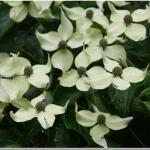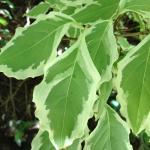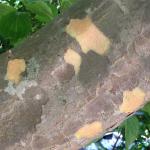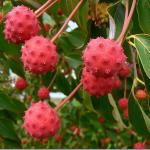A monthly e-newsletter from UMass Extension, published March to October, for home gardeners.
To read the articles in each section of the newsletter, click on the section headings below to expand the content:
Tips of the Month
September is the Month to…..
-
Start a compost pile. You can start a compost pile using disease and insect free plant material. Do not include weeds laden with seeds, because, even though some seeds will be killed during the composting process, those that survive will create a weed problem next year. Grass clippings and fallen tree leaves can be included. Locate your pile on a level area with good drainage and protected from strong winds, which can dry and cool the pile, slowing decomposition.
-
Plant spinach. Spinach seed can be sown in early September for fall and early winter harvest. Sow 12 to 15 seeds per foot of row. The rows may be as close as 12 inches apart. Cover seed 1/2 inch deep. When the plants are one inch tall, thin to 2 to 4 inches apart. If entire plants are to be harvested, closer spacing (no thinning) is satisfactory.
-
Aerate your lawn. September is a good time to aerate lawns growing on compacted areas, especially those that are subject to heavy foot traffic. Aeration relieves soil compaction, and improves water and nutrient movement in the soil. Aerate lawns with a core aerator, which have hollow metal tubes that remove plugs of soil or soil cores that are approximately 3/4 inch in diameter and 3 inches long. For best results, aerate lawns when the soil is moist. Avoid aeration when soils are dry or wet. The core aerator tubes will not be able to penetrate deeply when the soil is dry and may become plugged with soil when the soil is too wet.
-
Add organic matter in the soil. Adding organic matter in the soil improves the soil structure, increases the nutrient holding capacity of the soil, improves soil drainage and water holding capacity, provides plants nutrient, and increases the biological activity in the soil. Organic amendments can be added to the soil as manure or compost. These should be thoroughly incorporated into the soil when dry to prevent layering. This can be done by thoroughly rototilling the compost or manure after applying on the soil surface. Fall manure or compost application gives it time to break down and provide plant nutrients and other soil benefits in the spring.
-
Consider submitting soil to the lab for pH and nutrient testing at the end of the growing season. This will give you more time to plan your lime and fertilizer amendments for next year, and you will avoid the spring rush at the lab. Soil conditions will not change significantly over the cold winter months. Info at ag.umass.edu/services/soil-plant-nutrient-testing-laboratory.
-
Soil lead contamination is common in some urban and suburban communities, as well as around older homes painted with lead-based paint. Have your soil tested at UMass for Total Sorbed Metals to be sure your garden is safe! Info at ag.umass.edu/services/soil-plant-nutrient-testing-laboratory/ordering-information-forms.
-
Start fall clean up. Fall clean-up will help with the success of the garden next spring. Plants and weeds left over through the winter can harbor diseases and insect pests. Harvest all useable vegetables and annual flowers. Remove dead annual plants and weeds. Leftover disease free debris can be tilled into the soil, where it will decay and enrich the soil with organic matter. Clean up perennial beds.
-
Harvest apples as they ripen. The harvest period for apples varies from one cultivar to another. Harvest time may vary slightly from year to year due to weather conditions during the growing season. Mature apples are firm, crisp, juicy, well-colored and have developed the characteristic flavor of the cultivar. It is important to harvest fruits at the right stage of maturity in order to maintain quality and freshness. Ease of separation from the branch is a good indicator of maturity and ripeness. Avoid bruising the fruit during harvesting. Sort the apples during harvest, promptly removing and discarding bruised or cut apples.
-
Plant Garlic. Mid-September through October is a good time to plant garlic. Garlic needs a cold period for proper shoot and bulb development, and should to be planted at least six weeks before the soil freezes to allow enough time for good root growth but not enough time for leaves to emerge from the soil. Cloves are planted 3 to 4 inches deep, oriented with the root end down. In fall when it is cool and day length is short, garlic forms roots and begins sprouting. In spring, leaf growth resumes. Bulb formation is initiated in response to the longer days and warm temperatures of late spring in May and June. Bulb growth continues until the leaves turn yellow in July and the bulbs are ready for harvest.
-
Prepare a site for spring flowering bulbs. Late fall is the best time to plant hardy spring flowering bulbs. Preparing the soil properly for planting bulbs is very important, and good soil drainage is essential. If the soil has high clay content, add an organic amendment such as compost or plant in raised beds. If the soil is mostly sand, add an organic amendment such as compost to increase water and nutrient holding capacity.
-
Remove dropped fruits around crabapples and other fruit trees. Removing the dropped fruit from the ground helps to reduce insect and disease carryover. Dropped fruits can harbor disease pathogens and insect pests such apple maggot. Rake and remove all dropped fruits and compost or destroy them. These sanitation practices will reduce disease incidence next year.
-
Plant trees and shrubs. Early fall is a good time to plant trees and shrubs. Planting in early fall allows enough time for the plant to establish a root system during cooler weather. Fall conditions provide the greatest chance for successful establishment and for surviving the following year’s hot summer temperatures. Make sure you select healthy trees and shrubs to plant in the fall and keep the new transplants well watered. For more information on planting trees and shrubs, go to:
ag.umass.edu/landscape/fact-sheets/guidelines-for-planting-trees-shrubs
extension.unh.edu/resources/files/Resource000491_Rep513.pdf
Geoffrey Njue, UMass Extension Specialist
Timely Topics
Planning Ahead – Site Preparation
Planning ahead is not always a gardener’s forte. Many gardeners such as myself succumb to the spontaneity of nursery and garden center purchases, resulting in haphazard site preparation and the increased long-term maintenance that comes along with it. Now is a good time to avoid such blunders by planning ahead and properly preparing a planting site. Whether you plan on planting a blueberry patch, a new perennial bed, or a pollinator garden, site preparation will reduce long-term maintenance such as weeding and improve plant establishment. The keys to good site preparation include: weed control, building soil, nutrient and pH adjustments, and proper plant selection.
One of the most crucial steps in site preparation is the elimination of problematic plants such as perennial grasses, weeds or invasive plants. There are several ways to reduce perennial weeds, depending on how far you plan ahead. The quickest method for controlling perennial weeds is to use an herbicide such as glyphosate. Late summer/ early fall applications of glyphosate are very effective for vegetation control. Another option is smothering. Smothering with heavy plastic can be effective but requires more planning, since difficult to control plants may need to be smothered for an entire growing season or longer for sufficient control. Another material for smothering would be the use of cardboard or newspaper under a thick layer of compost. This can be successful for smothering plants like turf grasses. Cultivation, such as rototilling on a regular basis, can also be effective. However, like smothering with plastic, this may require an entire season or more to control problematic plants.
The next step is to build your soil by increasing the organic matter content. Organic matter improves many soil properties. In sandy soils, it improves water holding and nutrient holding capacities. In heavier clay soils, organic matter improves water penetration and drainage. In most soils, an organic matter content of 4-6% is ideal. To increase organic matter, consider using cover crops. Oats and field peas are good cover crop options for planting in the late summer / early fall. In addition to improving organic matter content, cover crops can suppress weeds and recycle nutrients. Organic matter can also be increased by liberal applications of compost or peat moss. Consider creating a compost pile at the place where you plan on using the finished compost. This could save some shoveling and wheel barrowing of compost later and be an easy way to manage leaves that will soon be falling.
Soil testing is another important aspect of site preparation. Soil testing provides you with the detailed information about your soil's chemistry as well as the recommendations needed to adjust fertility and soil pH for the specific plants you will be growing. Adjusting soil pH is not instantaneous; therefore, by doing a soil test in the fall, you will have ample time for adjustment prior to planting next spring. For more information about soil testing, see the UMass Soil & Plant Nutrient Testing Laboratory at ag.umass.edu/services/soil-plant-nutrient-testing-laboratory.
By preparing your site ahead of time, you will be able to avoid one of the most common planting mistakes - improper plant selection. Instead of impulse buying in the spring, you will be able to research and make informed decisions about your plant choices. The UMass Landscape, Nursery and Urban Forestry program has a large number of fact sheets to aid in selection of plant materials; ag.umass.edu/landscape/fact-sheets
So, take the time now to evaluate your yard and plan ahead for what your next big project is. Every bit of planning and site preparation now will increase your success and hopefully reduce some of your maintenance later.
Russ Norton, Cape Cod Cooperative Extension
News for Gardeners
UMass Garden Calendar Photo Contest
Ever take a great garden photo and think “this would be perfect for the UMass Garden Calendar?” We're holding a photo contest for the 2019 UMass Extension Garden Calendar, so have your camera handy and keep an eye out for contest-worthy pics! The deadline for submitting pictures is April 1, 2018. Submission details are at https://ag.umass.edu/landscape/publications-resources/garden-calendar/garden-calendar-photo-contest.
Ticks Are Active!
Remember to take precautions when working outdoors and to conduct daily tick checks. The UMass Amherst Laboratory of Medical Zoology tests ticks for Lyme Disease and other tick-borne pathogens. Visit the Tick Report website for more information at www.tickreport.com
Trouble Maker of the Month
Invasive Oriental Bittersweet (Celastrus orbiculatus)
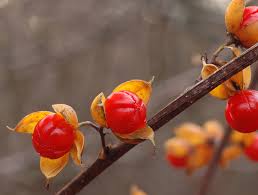 Oriental bittersweet is an invasive, deciduous vine found throughout New England. This woody perennial reproduces sexually by seed and asexually by creeping roots that sprout to form new stems. It can be observed growing as a brushy groundcover to a height of a few feet or as a climbing vine on trees where the vines may reach 40 to 60 feet. These climbing vines can negatively impact the health of native trees and shrubs.
Oriental bittersweet is an invasive, deciduous vine found throughout New England. This woody perennial reproduces sexually by seed and asexually by creeping roots that sprout to form new stems. It can be observed growing as a brushy groundcover to a height of a few feet or as a climbing vine on trees where the vines may reach 40 to 60 feet. These climbing vines can negatively impact the health of native trees and shrubs.
These vines can reach 3 to 4 inches in diameter. Leaves are alternate and round with crenate margins. Five-petaled, greenish-white flowers grow in clusters at the leaf axils and are somewhat inconspicuous. Flowering occurs in late spring and early summer. Oriental bittersweet is almost always dioecious, producing male (staminate) and female (pistillate) flowers on separate plants. This can readily be observed in the fall as the female plants will produce fruit and male plants will be fruitless. Individual fruits are about 1/3 inch, globoid-ovoid in shape, and smooth. At maturity, the outer husk of each fruit turns yellow and splits open into 3 parts to reveal a bright red, fleshy fruit that contains 1-2 seeds. The fruit is readily consumed by various birds and other small animals. Consumption of fruit by animals is known to aid in the spread of this invasive plant.
Oriental bittersweet is rarely affected by insect pests and disease organisms, which allows populations to grow unchecked in both landscapes and wild habitats. Humans can play a role in the spread of this invasive when they decide unwisely to use it as an ornamental plant in landscaping or collect branches of the colorful fruits for ornamental purposes.
Management
Physical/Mechanical: Oriental bittersweet is a prolific seed producer and seedlings/small plants are very common. As part of an ongoing maintenance program, these seedlings/small plants should be pulled by hand as they appear. After Oriental bittersweet is controlled with an herbicide, physical removal should be used as part of an ongoing management program to prevent regrowth.
Herbicides: Foliar applications of glyphosate will not control Oriental bittersweet, which will only cause temporary yellowing and the plant will recover in a short period of time. Foliar applications of triclopyr are a better postemergence choice. Alternatviely, glyphosate and triclopyr can be used as a cut stem/cut stump treatment. Whether to select a foliar treatment versus the cut stem/cut stump treatment will be determined by the growth habit of the Oriental bittersweet. In other words, is it growing as a groundcover (low growing brush) or a tree-climbing vine? Triclopyr can also be applied a basal bark treatment.
Final management note: Often home gardeners face a large population of Oriental bittersweet where both ground-sprawling and tree-climbing grow habits are present. In this situation, a home gardener may want to consider contacting a landscape or invasive plant management contractor.
Randy Prostak, UMass Extension Weed Specialist
Plant of the Month
Kousa dogwood (Cornus kousa)
Cornus kousa (Kousa dogwood) is one of a few, terrific landscape plants that have multi-seasonal appeal. It could be Plant of the Month for June, when it flowers. The white to creamy-white inflorescence, or “flower”, held above deep green 2-2 ½ inch leaves, is comprised of four white bracts that many people think are the “petals”. Each individual bract is about 1-2 inches long and approximately ¼ to ¾ inches wide. The four bracts surround the “true” small, almost inconspicuous, green–yellow flowers produced in an umbel in the center of the four white bracts, which usually persist for six weeks and sometimes even longer. Pollinators, like bees and butterflies, are attracted to the small flowers and, after pollinating them, a round green fruit (drupe) begins to form on a 2 to 2 ½ inch long pendulous stalk.
The round green fruit develops into a round, spherical raspberry-like, deep pink-red fruit that begins to color up in late August – early September and often persists into October. The fruit, while mealy and not very palatable, is edible and is also attractive to wildlife (birds, squirrels, etc). A showy display of these pink-red fruits dangling from the branches on the Kousa dogwood adds color and decorative visual interest to the September landscape, making it a good choice for Plant of the Month for September.
In autumn, the medium-dark green foliage gives way to a deep red-burgundy fall color, and, on older, more mature trees, after the leaves fall, a beautiful, mottled, exfoliating bark of tans, browns and grays can be seen, adding interest to the late fall, winter and early spring landscapes.
Cornus kousa is a small to medium (20 to 35 feet high with equal width), vase- shaped deciduous tree, native to China, Korea and Japan. It is a tree with no significant insect or disease problems. It is resistant to dogwood borer and dogwood anthracnose and, for those reasons, it is often planted as an alternative to our native Flowering dogwood, Cornus florida. Cornus kouse is also more drought tolerant than the native C. florida. Kousa dogwood may be planted in small groups, used as a specimen plant, or as a lawn plant, in a mixed shrub border, etc. However, be aware that it will drop its decorative fruit, so avoid planting this tree near a driveway or other areas where the fruit would become messy or become a maintenance problem.
Kousa dogwood grows best in an organic, well-drained, moisture-retentive soil, in full sun (6 or more hours), but will tolerate some light shade. It is winter hardy to Zone 5 and is an excellent low-maintenance, sustainable tree that provides landscape interest throughout the year.
There are numerous, perhaps 100 or more, Cornus kousa cultivars available, including some like ‘Benji Fuji’ or ‘Satomi’ with bright pink bracts. There are cultivars with green and white variegated foliage like ‘Wolf Eyes’ and ‘Samzan’ (Samaritan®); or cultivars with green foliage with a gold center (‘Gold Star’). There are weeping forms like ‘Elizabeth Lustgarten', ‘Lustgarten Weeping’, and ‘Weaver’s Weeping’, which may grow to a height of 12 to 15 feet and display downward arching branches covered in cascading white flowers in June.
Cornus kousa – a great plant for September as well as many other months; so many cultivars, so little time.
Deborah C. Swanson, Horticulturist
Additional Resources
Landscape Message - for detailed timely reports on growing conditions and pest activity
Home Lawn and Garden Resources
Find us on Facebook! https://www.facebook.com/UMassExtLandscape/
Follow us on Twitter for daily gardening tips and sunrise/sunset times. https://twitter.com/UMassGardenClip
Diagnostic Services
The UMass Extension Plant Diagnostic Lab provides, for a fee, woody plant and turf disease analysis, woody plant and turf insect identification, turfgrass identification, weed identification, and offers a report of pest management strategies that are research based, economically sound and environmentally appropriate for the situation. Accurate diagnosis for a turf or landscape problem can often eliminate or reduce the need for pesticide use. Sampling procedures, detailed submission instructions and a list of fees.
The UMass Soil and Plant Nutrient Testing Laboratory at the University of Massachusetts Amherst provides test results and recommendations that lead to the wise and economical use of soils and soil amendments. The Routine Soil Analysis fits the needs of most home gardeners. Sampling procedures plus the different tests offered and a list of fees.
Spread the Word!
Share this newsletter with a friend! New readers can subscribe to our Home Gardener E-Mail List.
